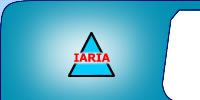

 |
International Conference on Internet and Web Applications and Services ICIW 2006 February 23-25, 2006 - Guadeloupe, French Caribbean |
| Tutorials |
Note: A tutorial takes place when a minimum of 6 attendees register.
T1: Web Mining [half day]
by Vladan Devedžić
T2: Advances in the Semantic Web [half day]
by Vladan Devedžić
T3: Semantic Web Services [full day]
by Liliana Cabral, John Domingue, Dumitru Roman, Michael Stollberg, Tomas Vitar, and Michal Zaremba
T4: New Internet and Networking Technologies for Grids and Web-based Computing [half day]
by Congduc Pham
Speakers:
Vladan Devedžić is both an active researcher and practitioner in the fields of intelligent systems and software engineering. His major long-term professional goal is a continuous effort to bring close together the ideas from the broad fields of intelligent systems and software engineering. In that sense, his current efforts and research interests are oriented towards practical engineering aspects of developing intelligent educational systems on the Web. He has written more than 250 papers (46 of them have been published in internationally recognized journals by publishers such as ACM, IEEE, Pergamon Press, etc.), four books on intelligent systems, and several chapters in books on intelligent systems and software engineering edited by distinguished scientists. He has also developed several practical intelligent systems and tools, and actively participates as a consultant to several ongoing projects in industry. He is an associated partner at the EU Framework 6 IST Network of Excellence project ProLearn, and a member of the ARIADNE Foundation for the European Knowledge Pool.
John Domingue is the Deputy Director of the Knowledge Media Institute. He has published over 80 refereed articles in the areas of Artificial Intelligence, Learning and Human Computer Interaction. Over the last decade he has focused on how ontologies and Web technologies can facilitate knowledge sharing and learning. His current work is focused around the Internet Reasoning Service (IRS) which is a WSMO compliant framework and platform for creating and deploying semantic Web services. The IRS has already been used in a number of hands on sessions to educate 150 learners. He is a co Investigator on the UK EPSRC funded Advanced Knowledge Technologies (AKT) project, the Scientific Director of the EU funded Integrated Project on Semantic Web services DIP and a chair of the WSMO working group. John Domingue will Chair next year's European Semantic Web Conference and will be the programme chair for AIMSA 2006.
Liliana Cabral is a research fellow at the Knowledge Media Institute, The Open University, working on the DIP project. Her main research focuses on mediation in the context of semantic Web services and additionally, she is co-responsible for the design and implementation of IRS-III, a framework and infrastructure for Semantic Web services. Previous projects include MIAKT where knowledge technologies from the AKT project were combined with medical imaging technology and GRID services to support the diagnosis of breast cancer. She sits on the programme committee of the major semantic Web conferences and is the Workshop Chair for next year's European Semantic Web Conference.
Michael Stollberg is a researcher with the Digital Enterprise Research Institute DERI, working in the area of Semantic Web Services. He is a founding member of the WSMO working group, project manager of the Semantic Web Fred project and workpackage manager in the DIP project.
Dumitru Roman is a Ph.D. researcher with the Digital Enterprise Research Institute DERI, working in the area of Semantic Web Services. He is the WSMO working group coordinator and a component leader in the ASG project, involved in several EU-funded projects, and founding member of WSMO and WSML working groups.
Michal Zaremba is a post-doc researcher with the Digital Enterprise Research Institute DERI, working as developer and system architect in Semantic Web Service systems. He is involved in several national and international projects, a founding member of the WSMO and WSMX working group, and member of the Semantic Web Services Interest Group and the Semantic Web Services Architecture Committee (SWSA).
CongDuc Pham obtained his PhD in Computer Science in July 1997 at the LIP6 Laboratory (Laboratoire d'Informatique de Paris 6), University Pierre and Marie Curie. He also received his Habilitation in 2003 from University Claude Bernard, Lyon, France. He spent one year at the University of California, Los Angeles (UCLA) as a post-doctoral fellow. From 1998 to 2005, he was associate professor at the university of Lyon, member of the INRIA RESO project in the LIP laboratory at the ENS Lyon. He is now at the university of Pau and the LIUPPA laboratory. His research interests include parallel discrete event simulation, cluster computing, active networking and networking protocols. He has been involved in several grid computing projects from the networking perspective. He has published more than 30 papers in international conferences and journals, has been reviewers for a numerous of international conferences and magazines, and has participate to several conference program committees. He is a member of IEEE.
Content:
T1 Description:
The tutorial starts with an introduction of basic concepts and ideas of KDD (15 min). Then it explains all the phases in the KDD process, paying particular attention to data mining techniques (15 min). Web mining and other recent trends in KDD are discussed extensively (1 hr), and then a number of existing systems and development tools are analyzed (1 hr 30 min), in order to show how the basic ideas are implemented in practice. Specifically, the topics and the application areas considered are:
. KDD as a process
. typical data mining tasks
. the most important data mining algorithms
. Web mining - mining patterns in data on the Web
. text mining
. mining digital libraries, scientific databases, and multimedia databases
. measures of interestingness of discovered knowledge
. the role of visualization in pattern interpretation
. the role of data warehouses in KDD
. development tools for Web mining
. selected applications
. Web content mining applications
. Link structure mining applications
. Web usage mining applications
. image analysis using KDD
. industrial and scientific applications of KDD
. text mining applications
. coupling KDD applications with intelligent agents
. commercial aspects of KDD systems
. KDD and data mining as parts of other applications
Throughout the tutorial, relations between KDD and other disciplines are stressed. KDD and data mining techniques come as a natural extension and integration of many other techniques, used in the fields of statistics, knowledge-based systems, machine learning, object-oriented systems, neural networks, etc. Numerous practical examples from existing applications are used to illustrate this point.
T2 Description:
The tutorial starts with a brief introduction to the basic concepts and ideas of ontologies, knowledge sharing on the Web, and intelligent agents (15 min in a 3-hour tutorial, or 30 min in a 6-hour tutorial). Then it discusses extensively the advances achieved over the last few years in developing models, languages, architectures and tools for the Semantic Web (1 hr 15 min / 2 hr 30 min). Special attention is given to the most recent trend in the Semantic Web, that of applying the Model-Driven Architectures (MDA) to the Semantic Web applications. A number of existing software tools, applications, systems and development environments are then analyzed in order to illustrate current Semantic Web technology and to indicate directions for future developments (1 hr 30 min / 3 hr). Specifically, the topics covered are:
- The Semantic Web languages today
- The Semantic Web services
- state-of-the art tools for developing ontologies
- integration of agent technology and ontologies into Web-based systems
- architectural aspects of the Semantic Web applications
- The Semantic Web and MDA
- ontology engineering vs. software engineering of the Semantic Web
- selected examples, languages, systems, and ongoing projects
- tools for creating Semantic Web contents
- existing ontologies for Semantic Web applications
- ontology-aware authoring tools
During the tutorial, the attendees are supposed to work interactively with the tutorial presenter on at least one practical example, using appropriate Semantic Web software tools.
T3 Description:
The following outlines the planned content of the tutorial and organizational issues concerning timing and presentation structure.
The tutorial consists of five main sections that subsequently provide a complete overview of Semantic Web Services and the latest status related technology developments. With respect to the background of the presenters, the tutorial will be centered around the Web Service Modeling Ontology WSMO and discuss differences and commonalities with other efforts. The tutorial parts will be presented in following order:
1) Introduction to Semantic Web Services
This section introduces the idea and challenges of Semantic Web Services, as the basis of the subsequent sections comprising the following aspects:
- vision of Semantic Web Services
- current Web Services technologies
- challenges for Semantic Web Services
2) Semantic Web Services Frameworks
In order to provide sophisticated solutions for Semantic Web Services, technologies need to be positioned in an overall framework. Currently OWL-S and the Web Service Modeling Ontology WSMO represent the most significant conceptual models for Semantic Web Services; both are complementary and together provide a promising basis for Semantic Web Services. This section introduces both frameworks with regard to:
- motivation, scope, and design principles
- conceptual model and building blocks
- explanation of the components specification
- commonalities and differences
3) Semantic Techniques for Web Services
On basis of the preceding parts, concrete approaches and solutions for specific Semantic Web Service technologies are presented. This part is comprised of the most recent results from different research and development efforts. It encompasses solutions for:
- Semantic Description of Web Services
- Web Service Discovery and Composition
- Invocation of Web Services
- Conversation Validation
- Mediation and Interoperability
4) Semantic Web Service Tools and Systems
With regard to the theoretical background provided in the previous sections, this part of the tutorial presents selected tools and systems for handling and using Semantic Web Services. In particular, the tools for the following operations are presented:
- The Web Service Execution Environment WSMX (WSMO reference implementation)
- IRS3: a bridge system between OWL-S and WSMO
5) Hands-On Session
As the final part of the tutorial, attendees practically create and work with Semantic Web Services on basis of the techniques and systems presented in the previous tutorial parts. Experience in previous tutorials has proven this section as very helpful for attendees, as the most you learn we you actually do it yourself. The hands-on session is run in small working groups of attendees that are lead by one presenter and is structured as follows:
- introduction of the tools to be used
- demonstration of application to be constructed and available resources
- assisted hands-on session.
In order to achieve the aspired results of the tutorial for attendees as outlined, we propose a full day tutorial with an agenda as displayed in the following table. The timing will of course be adjusted with the overall WW 2006 conference organization.
Table 1 : Agenda for Full Day Tutorial on Semantic Web Services
Time |
Content |
09.00 |
Start, welcome |
09.00 - 09.30 |
Section 1: Introduction to Semantic Web Services |
09.30 - 10.30 |
Section 2: Semantic Web Services Frameworks |
10.30 - 11.00 |
Coffee break |
11.00 - 12.30 |
Section 3: Semantic Techniques for Web Services |
12.30 - 14.00 |
lunch |
14.00 - 15.00 |
Section 4: Semantic Web Service Tools and Systems |
15.00 - 15.30 |
Coffee break |
15.30 - 17.00 |
Section 5: Hands-On Session |
17.00 |
wrap-up, closing |
T4 Description:
Internet technologies are used daily by millions of people worldwide for communication, work or even entertainment. The Internet has very rapidly become part of the scientist's life for exchanging information, first with e-mail, and then with the World Wide Web (WWW) which has truly revolutionized the way the scientific community is cooperating. Since the WWW revolution in 1993, we are now at the dawn of a new revolution consisting in using the Internet/Web infrastructure for complex problem solving and for more cooperation in a large variety of Computational Sciences. This talk will briefly present the emerging computational grid technologies and infrastructures, and then focuses on the new Internet technologies such as DiffServ, MPLS, Multicast and Overlay networks, Active networking and high performance transport protocols; that will be very soon released for providing high-bandwidth, secure and ubiquitous connectivity for a new era of scientific applications. Besides presenting in a didactic manner how these new technologies work, examples will be given throughout the tutorial to show how these new technologies could be deployed and used on grid or web-based infrastructures.
Since the WWW revolution in 1993, we are now at the dawn of a new revolution consisting in using the Internet/Web infrastructure for complex problem solving and for more cooperation in a large variety of Computational Sciences. This talk will briefly present the emerging computational grid technologies and infrastructures, and then focuses on the new Internet technologies such as DiffServ, MPLS, Multicast and Overlay networks, Active networking and high performance transport protocols; that will be very soon released for providing high-bandwidth, secure and ubiquitous connectivity for a new era of scientific applications. Besides presenting in a didactic manner how these new technologies work, examples will be given throughout the tutorial to show how these new technologies could be deployed and used on grid or web-based infrastructures.